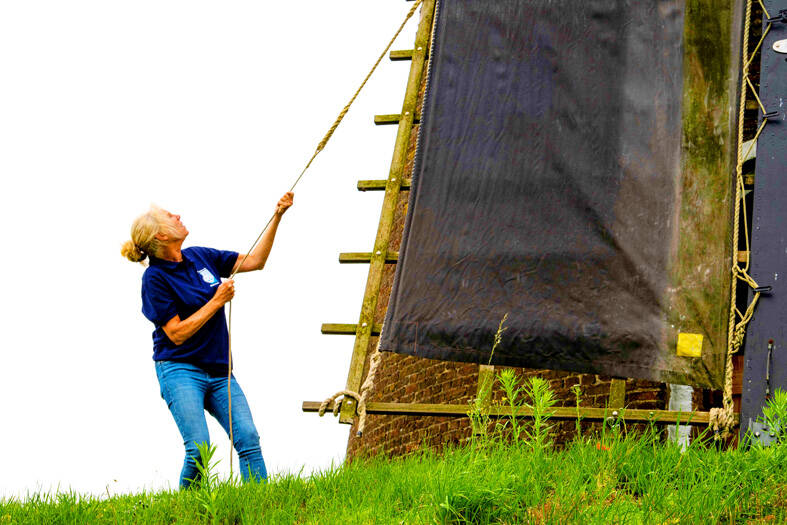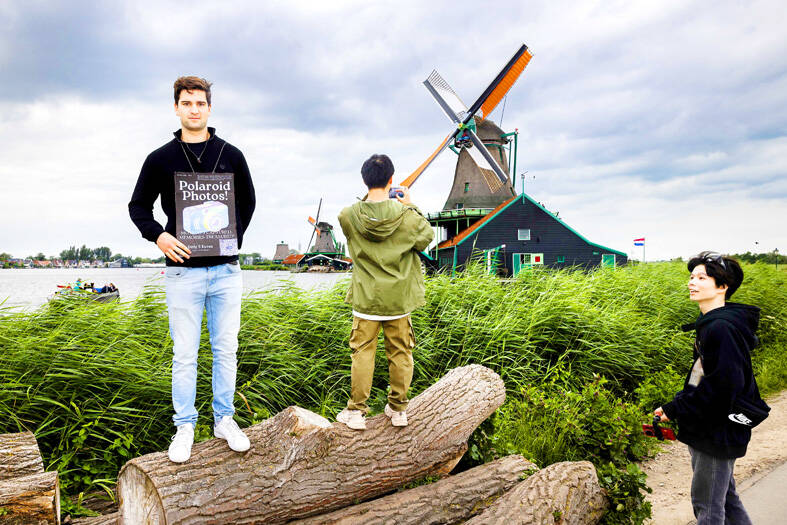Dutch artist Peet Wessels might not call it an obsession, but with more than 100 images of windmills in her home, it is clear she is a big fan — her walls practically whirl with admiration.
Now Wessels, who rose to fame by painting windmills on the mill’s used canvas sails, is taking it one step further.
She is training to become a real miller — someone who operates and maintains a windmill — joining a growing number of women in what was once seen as a man’s world.

Photo: AFP
It was a blustery afternoon at De Heimolen, an ancient wheat mill in Rucphen-Bosschenhoofd near the southern Dutch city of Breda.
Perched some 10m on one of the four wings of the mill, built in 1866, Wessels tied canvas over the wooden slats. She then scarpered down and ran around the structure to release a brake to set the creaking blades in motion.
“You cannot have a fear of heights if you want to be a miller,” Wessels said, dressed in sturdy boots, jeans and a hoodie bearing the insignia of the Dutch Guild of Millers.

Photo: EPA-EFE
For almost two years now, Wessels, 59, has been following the ancient course on how to become a miller, joining about 2,000 others in the Netherlands, famous for its clogs, cheese and windmills.
Wessels believes she is the only female miller in the North Brabant province, a short hop from one of the country’s most iconic windmill locations at the nearby Kinderdijk.
In all, there are about 200 female millers around the Netherlands, she said.
They are mostly based around the central city of Utrecht.
Trainee millers learn mill mechanics — how to steer the massive blades without damaging them, safety around the rapidly moving parts and how to read the weather.
“It’s a bit like being the captain of a sailing ship,” Wessels said.
Asked about female millers making waves in a role seen for centuries as traditionally male, Wessels did not think of herself as a pioneer.
“But I’d rather be in a mill than attending a fashion show,” she said, laughing.
A chemical engineer by profession, Wessels said she was always interested in windmills and how they worked.
After stints as an engineer in the UK and the US, she started a new career as a painter in the late 1990s.
However, sales dropped and after the credit crunch in 2008, Wessels knew she had to innovate “and do something different.”
One day she was cycling past a windmill when she hit upon an idea.
“I told the miller I want do something with mills and paint them, do you have something I could use?”
That’s when the miller showed her the used canvas cloth used in the mill’s wings — and so an idea was born.
“It was stinky and full of insects, so I had to scrub it clean first,” she said.
Her chemical engineering background came in handy, helping her to find the right way to treat the canvas to show the painting and the cloths’ natural aging process.
“The cloth and the painting had to work together. It has to show the history of the cloth that’s been on the mill sometimes for 20 years or longer,” she said.
Wessels’ painting of the mill also exactly matches the actual mill on which the canvas was used.
Two of her favorites now hang in her kitchen: one work called Dutch Skies and another called Dutch Landscape.
Both were painted on the canvas from the 1740 Overwaard 7 mill at Kinderdijk — which has been declared a UNESCO World Heritage site because of its 19 iconic mills.
Wessels has painted almost all of the Netherlands’ famous windmills — including a mill called De Kat north of Amsterdam — the world’s last remaining windmill using wind power to make paint pigment.
“Almost all the millers know me. I used to ask for old canvas, but now they phone me when they have some available,” Wessels said.
Asked if she ever dreams of windmills, she quipped: “I’m not a fanatic, but training to become a miller is perhaps a step closer.”

Shares in Taiwan closed at a new high yesterday, the first trading day of the new year, as contract chipmaker Taiwan Semiconductor Manufacturing Co (TSMC, 台積電) continued to break records amid an artificial intelligence (AI) boom, dealers said. The TAIEX closed up 386.21 points, or 1.33 percent, at 29,349.81, with turnover totaling NT$648.844 billion (US$20.65 billion). “Judging from a stronger Taiwan dollar against the US dollar, I think foreign institutional investors returned from the holidays and brought funds into the local market,” Concord Securities Co (康和證券) analyst Kerry Huang (黃志祺) said. “Foreign investors just rebuilt their positions with TSMC as their top target,

REVENUE PERFORMANCE: Cloud and network products, and electronic components saw strong increases, while smart consumer electronics and computing products fell Hon Hai Precision Industry Co (鴻海精密) yesterday posted 26.51 percent quarterly growth in revenue for last quarter to NT$2.6 trillion (US$82.44 billion), the strongest on record for the period and above expectations, but the company forecast a slight revenue dip this quarter due to seasonal factors. On an annual basis, revenue last quarter grew 22.07 percent, the company said. Analysts on average estimated about NT$2.4 trillion increase. Hon Hai, which assembles servers for Nvidia Corp and iPhones for Apple Inc, is expanding its capacity in the US, adding artificial intelligence (AI) server production in Wisconsin and Texas, where it operates established campuses. This

H200 CHIPS: A source said that Nvidia has asked the Taiwanese company to begin production of additional chips and work is expected to start in the second quarter Nvidia Corp is scrambling to meet demand for its H200 artificial intelligence (AI) chips from Chinese technology companies and has approached contract manufacturer Taiwan Semiconductor Manufacturing Co (TSMC, 台積電) to ramp up production, sources said. Chinese technology companies have placed orders for more than 2 million H200 chips for this year, while Nvidia holds just 700,000 units in stock, two of the people said. The exact additional volume Nvidia intends to order from TSMC remains unclear, they said. A third source said that Nvidia has asked TSMC to begin production of the additional chips and work is expected to start in the second

US President Donald Trump on Friday blocked US photonics firm HieFo Corp’s US$3 million acquisition of assets in New Jersey-based aerospace and defense specialist Emcore Corp, citing national security and China-related concerns. In an order released by the White House, Trump said HieFo was “controlled by a citizen of the People’s Republic of China” and that its 2024 acquisition of Emcore’s businesses led the US president to believe that it might “take action that threatens to impair the national security of the United States.” The order did not name the person or detail Trump’s concerns. “The Transaction is hereby prohibited,”